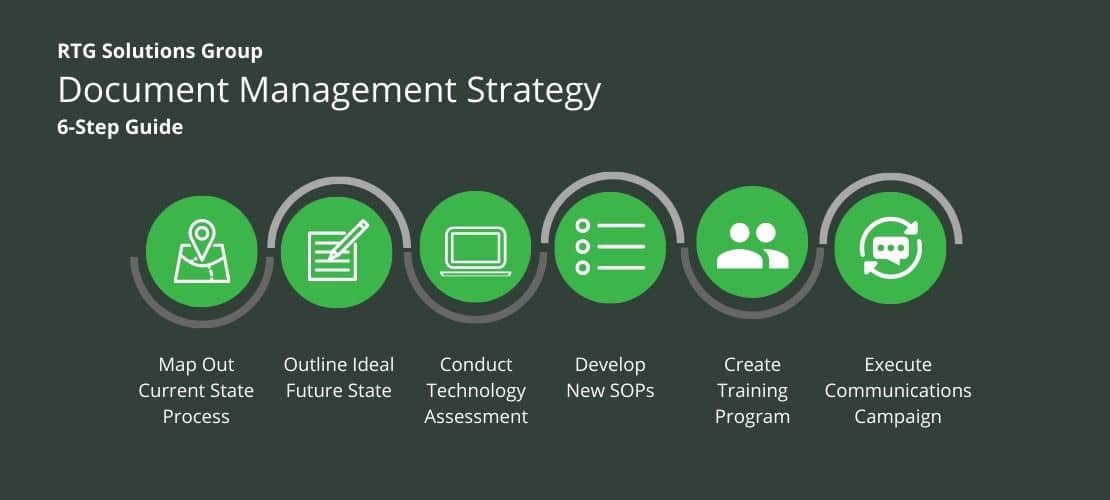
Document management is like the business equivalent of doing your laundry. It’s a multi-step process. It involves a lot of sorting. If you hand it off to the wrong person, it can cause permanent damage. And if you don’t stay on top of it, you’ll end up with a huge mess on your hands!
If you’re looking to implement a document management strategy but don’t know where to start, you’ve come to the right place!
Document management can be a daunting task–especially if your business has suffered from poor document management for years. That’s why we’re sharing our complete guide to document management strategy.
At RTG Solutions Group, our document management experts have been doing this for years. We’ve seen just about every document management nightmare you could imagine. From file cabinet fire hazards to cloud-storage security risks, we’ve seen (and solved!) it all.
In helping our clients over the years, we’ve learned the most important steps to include in a document management overhaul.
Here is our 6-step formula for a successful document management strategy plan:
-
- Map out current-state processes
- Outline ideal future-state
- Conduct technology assessment
- Develop new Standard Operating Procedures (SOPs)
- Create document management training program
- Execute communications campaign
Before we dive into the details, let’s answer some important questions about document management.
WHAT IS A DOCUMENT MANAGEMENT STRATEGY?
A document management strategy is a roadmap used to improve document management in your business. It’s a plan you follow to get your document operations from point A to point B.
This is not to be confused with document management workflow. A document management workflow is the set of processes, security protocols, tools, SOPs, and technology used to manage documents.
Essentially, a document management strategy is a plan to create and implement more efficient document workflows.
WHY DO I NEED A STRATEGY FOR DOCUMENT MANAGEMENT CHANGES?
Documents are the lifeblood of your business. They contain all of the information that makes your business valuable. Without proper document management protocols, you can expose your business to a number of liabilities. These include:
- Regulatory compliance violations
- Information security risks
- Lost documents
- Document errors
- Wasted time
- Impaired productivity
- Employee frustration
- Supply chain disruptions
- Inventory management errors
- Contract violations
These are just a few of the problems organizations face when managing their documents. And all of these issues can be exacerbated if you try to change your document management approach without a safe plan.
If your organization is having issues with document management, launching a new document system without preparation is just about the worst thing you can do.
Document management entails much more than the latest technology. You need to analyze and change your business processes with a holistic, strategic plan.
And that’s where the strategy comes in. A strong plan will allow you to address problems in your current workflows and avoid complications during the implementation process.
To learn more about how improper document management creates business risks, check out our article: 3 Biggest Risks of Poor Document Management Workflow!
1. MAP OUT CURRENT-STATE PROCESSES

Number one on the to-do list: assess your current-state processes. This means poring over your SOPs and gathering as much information as possible about how things are currently done.
The best way to approach this step is with a thorough needs analysis. A comprehensive needs assessment will not only show you how documents are currently managed in your business. It will also reveal to you where the problems lie.
At RTG Solutions Group, as part of our needs assessments, we produce a clear map of your current document processes. This serves as our starting point for your new and improved document management plan.
Want to learn more about how a needs assessment can help you solve business problems? Check out our article: 7 Steps to Execute a Needs Analysis
2. OUTLINE IDEAL FUTURE STATE
Now that you’ve mapped out all of your current state processes, it’s time to outline your future state. The future state is your “goal” document management process.
We believe the best path to a goal state starts with a map of your current state. This should capture how your organization currently creates, processes, stores, deletes, and shares all documents in the business.
Once we create this map, we carefully analyze it to identify where the problems, oversights, bottlenecks, and inefficiencies lie. It is only after we understand problems with your current state that we create the ideal future state.
3. CONDUCT TECHNOLOGY ASSESSMENT
The third step is to conduct a technology assessment. You can skip this step if your organization already has a document management system (or a Learning Management System with document management capabilities).
For this step, you’ll want to assess your options for electronic document management systems. There’s no one document management system that works for all businesses. You have to find the one that works for your organization’s needs, goals, and budget.
This step should involve a cost-benefit analysis for different software options. Working with a vendor-neutral partner like RTG Solutions Group will ensure that you select the best software for your business.
Our document management consultants will do more than just recommend a piece of technology and walk away. We will work closely with your IT team to implement the technology and conduct system tests to make sure everything runs smoothly on roll-out day.
Important note: Far too often, this is the first and only step organizations take when changing their document management approach. Switching to a new document management system without a comprehensive strategy is certain to worsen your problems. We believe technology implementation should be one component of a greater, customized improvement plan.
4. DEVELOP NEW STANDARD OPERATING PROCEDURES
Once you’ve selected your new document management software, you need to create new Standard Operating Procedures (SOPs) for managing documents. Your SOPs should cover all aspects of document management, including:
- Creation
- Retrieval
- Revisions and version control
- Access and permissions
- Disposal
- Sharing
The importance of this step cannot be overstated! SOPs will serve as the foundation for your new document management process.
If you don’t flesh out a comprehensive set of SOPs, there is no guarantee your new document management system will increase efficiency.
At RTG Solutions Group, our consultants will create SOPs for every document management function to ensure a successful transition. In addition, we will document the new SOPs and create a training program to bring employees up to speed with the new processes.
5. CREATE DOCUMENT MANAGEMENT TRAINING PROGRAM
Once you’ve documented your new SOPs, lock them up in a safe place where nobody will ever find them. Just kidding – see how crazy that sounds? Well, if you don’t share SOPs with staff through document management training, you may as well be throwing them away!
Learning and development is a crucial step in your document management strategy plan. Training is what gives employees the ability to carry out your new SOPs. Without training, your new document management process will just create confusion and frustration.
At RTG Solutions Group, our experts will create a custom training program (in-person or remote) to solidify your document management transition.
6. EXECUTE COMMUNICATIONS CAMPAIGN
A document management strategy is a major business change. For this reason, you need to create a targeted change communications campaign.
A communications campaign will ensure that all staff are informed as to when, why, and how the document management change is happening.
Effective communication during times of change has several benefits:
- It makes employees feel included in the document management change
- It helps to manage employee expectations about the document management change
- It helps leaders execute the change by keeping stakeholders informed
- It contextualizes the change within greater organizational goals
At RTG Solutions Group, our document management consultants are also experts in change management. We will work with your internal communications staff and leadership to create and execute communications regarding the new document management process.
CONCLUSION
Implementing a new document management strategy can be intimidating. Taking a comprehensive, analysis-driven approach is the best way to make a document management change successful.
At RTG Solutions Group, these 6 steps are the foundation of our document management planning process. Our experts will guide your organization through every step of improving the way your documents are managed.
Want more information about our comprehensive, personalized document management consulting services? Contact us today!
